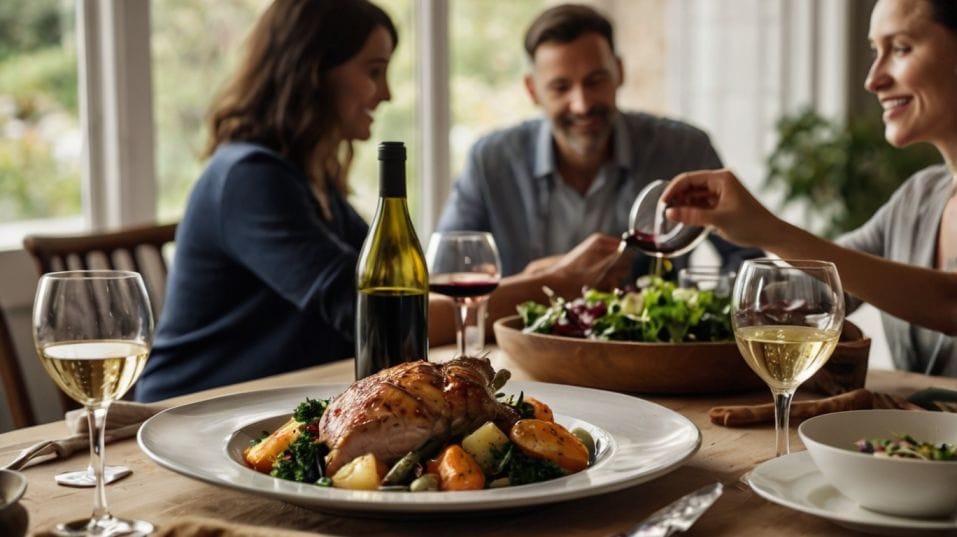What to Pour at a Dinner Party (Without Overthinking It)
Learn how to choose dinner party wines with ease, not ego. Build a go-to lineup that matches food, vibe, and conversation effortlessly.

What if choosing wine for a dinner party felt more like setting a vibe than passing a test? You don’t need deep cellar knowledge or a sommelier pin.
Just a sense of the room and a bottle that supports the moment. The goal isn’t impressing—it’s welcoming.
Whether it’s crisp and bright or textured and grounding, wine should help shape the rhythm of the night, not dominate it. Here’s how to pour with intention—not pressure.
Start With Energy, Not Ego
When guests arrive, they’re stepping into a new atmosphere. Give them something that acts like a reset—bright, cool, and refreshing.
This is less about wine complexity and more about tone-setting. You want something that feels crisp and alive.
A dry sparkling wine works beautifully here. You don’t need Champagne to get the effect—a Crémant, Cava, or well-made pét-nat brings lift without the price tag.
The bubbles invite conversation. They clear the palate. They feel celebratory without trying too hard.
Still wines can do the same job. Think coastal whites with minerality and zip: a Portuguese Arinto, a Sicilian Carricante, or a Muscadet from the Loire. These wines aren’t loud—they’re clean, bracing, and versatile. They wake people up.
Rosé also fits this moment—especially if you lean toward structured, savory styles. Look for rosés that see a bit of lees contact or come from limestone soils.
They’ll have texture without getting flabby, and they play well with snacks, salty bites, and ambient conversation.

With Food, Don’t Chase Perfection—Find Balance
The idea of pairing wine “perfectly” with food is overrated, especially when you’re feeding a group. Real dinner tables aren’t tasting menus.
People are reaching for different dishes at different times. That’s why the smartest bottle isn’t the most precise—it’s the most forgiving.
Versatile Reds That Work the Table
Versatility is your best tool. Medium-bodied reds with good acidity and minimal oak tend to go farther than almost anything else. Wines like:
- Barbera (from Piedmont): Bright fruit, soft tannins, high acidity.
- Garnacha (from Spain or southern France): Juicy, spicy, and generous.
- Cru Beaujolais (especially Morgon or Fleurie): Structured but agile.
- Etna Rosso (from Sicily): Earthy, lifted, and complex without heaviness.
These wines can handle a range of dishes—from roasted meats to grilled vegetables to anything with tomatoes, herbs, or olive oil.
The key here is freshness. Acidity helps wine act like a seasoning—it sharpens flavors, clears fat, and keeps the palate alert.
Fuller Whites for Lighter Menus
If your menu leans lighter—think seafood, vegetables, grains—a fuller-bodied white may be the move. Try:
- Chenin Blanc (from the Loire): Textured, floral, and often a bit honeyed.
- Grüner Veltliner (from Austria): Peppery and angular, with citrus lift.
- White Rhône blends: Rich and waxy, but grounded by herbal tones.
These aren’t showy wines, but they do something. They shift with the food and invite a second glass.
Give Your Guests Something to Talk About
Dinner parties aren’t lectures. But a well-chosen bottle can spark conversation—especially if it’s unexpected. That doesn’t mean obscure or intimidating. It means introducing something with a backstory or a signature flavor profile.
A skin-contact white might intrigue even casual drinkers—it looks like a rosé, tastes like a tea, and opens up across the evening.
An alpine red from northern Italy (like a Schiava or a Lagrein) surprises people with its lightness and perfume. Even something as familiar as Zinfandel, if chosen carefully, can taste totally new when it’s made with restraint and clarity.
These aren’t wines for every guest, or every night. But offering one bottle that’s a little off-center gives people something to latch onto. And more often than not, that’s the wine they’ll remember.
Don’t Forget the Final Pour
As the night winds down, you can use wine to shift the pace. This is your moment to pull out something contemplative. Not heavy. Not cloying. Just enough to encourage a slower sip and a longer conversation.
A chilled red with a touch of funk can bring surprising depth at this point—think Pineau d’Aunis or Trousseau. A demi-sec Vouvray gives just enough sweetness without veering into dessert territory.
Or go fortified: a small pour of Madeira, aged Marsala, or tawny Port rounds out the night with warmth and gravity. This pour isn’t about impressing anyone. It’s about creating a mood. Something to settle into.
Build Your Repertoire, Not Your Cellar
You don’t need 200 bottles. You need five or six that you understand. Wines you know how to use. That might mean:
- A crowd-pleasing white with texture and snap.
- A red that pairs with more dishes than it doesn’t.
- A sparkling bottle for energy and lift.
- A wildcard you love enough to explain.
- Something soft and slow for the end of the meal.
When you know what each bottle brings to the table, you stop second-guessing your choices.
You start pouring with intention—not because it’s trendy, or expensive, or recommended by someone else, but because it feels right for the moment.
Final Thoughts
Wine doesn’t have to be the star of your dinner party. But it should support the vibe you’re trying to create. Choose bottles that enhance connection, food, and flow—not ones that interrupt them.
Let freshness lead. Trust that versatility is more powerful than perfection. And if you’re unsure? Pour something you’re curious about.
Tonight, grab a bottle you’ve never tried. Pour it with purpose. Notice what it brings to the table, how it moves through the meal, what kind of conversations it inspires.
You don’t have to know everything. You just have to taste—and keep tasting. That’s how good instincts are built.




